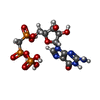+Search query
-Structure paper
| Title | Tubulin isoform composition tunes microtubule dynamics. |
|---|---|
| Journal, issue, pages | Mol Biol Cell, Vol. 28, Issue 25, Page 3564-3572, Year 2017 |
| Publish date | Dec 1, 2017 |
 Authors Authors | Annapurna Vemu / Joseph Atherton / Jeffrey O Spector / Carolyn A Moores / Antonina Roll-Mecak /   |
| PubMed Abstract | Microtubules polymerize and depolymerize stochastically, a behavior essential for cell division, motility, and differentiation. While many studies advanced our understanding of how microtubule- ...Microtubules polymerize and depolymerize stochastically, a behavior essential for cell division, motility, and differentiation. While many studies advanced our understanding of how microtubule-associated proteins tune microtubule dynamics in trans, we have yet to understand how tubulin genetic diversity regulates microtubule functions. The majority of in vitro dynamics studies are performed with tubulin purified from brain tissue. This preparation is not representative of tubulin found in many cell types. Here we report the 4.2-Å cryo-electron microscopy (cryo-EM) structure and in vitro dynamics parameters of α1B/βI+βIVb microtubules assembled from tubulin purified from a human embryonic kidney cell line with isoform composition characteristic of fibroblasts and many immortalized cell lines. We find that these microtubules grow faster and transition to depolymerization less frequently compared with brain microtubules. Cryo-EM reveals that the dynamic ends of α1B/βI+βIVb microtubules are less tapered and that these tubulin heterodimers display lower curvatures. Interestingly, analysis of EB1 distributions at dynamic ends suggests no differences in GTP cap sizes. Last, we show that the addition of recombinant α1A/βIII tubulin, a neuronal isotype overexpressed in many tumors, proportionally tunes the dynamics of α1B/βI+βIVb microtubules. Our study is an important step toward understanding how tubulin isoform composition tunes microtubule dynamics. |
 External links External links |  Mol Biol Cell / Mol Biol Cell /  PubMed:29021343 / PubMed:29021343 /  PubMed Central PubMed Central |
| Methods | EM (single particle) |
| Resolution | 4.2 Å |
| Structure data | |
| Chemicals |  ChemComp-G2P:  ChemComp-MG:  ChemComp-GTP: |
| Source |
|
 Keywords Keywords | STRUCTURAL PROTEIN / Microtubules Dynamics Tubulin Isoform |
 Movie
Movie Controller
Controller Structure viewers
Structure viewers About Yorodumi Papers
About Yorodumi Papers





 homo sapiens (human)
homo sapiens (human)